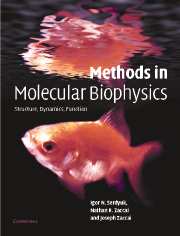Book contents
- Frontmatter
- Contents
- Foreword by D. M. Engelman
- Foreword by Pierre Joliot
- Preface
- Introduction: Molecular biophysics at the beginning of the twenty-first century: from ensemble measurements to single-molecule detection
- Part A Biological macromolecules and physical tools
- Part B Mass spectrometry
- Part C Thermodynamics
- Part D Hydrodynamics
- Part E Optical spectroscopy
- Part F Optical microscopy
- Part G X-ray and neutron diffraction
- Part H Electron diffraction
- Part I Molecular dynamics
- Part J Nuclear magnetic resonance
- Chapter J1 Frequencies and distances
- Chapter J2 Experimental techniques
- Chapter J3 Structure and dynamics studies
- References
- Index of eminent scientists
- Subject Index
- References
Chapter J2 - Experimental techniques
from Part J - Nuclear magnetic resonance
Published online by Cambridge University Press: 05 November 2012
- Frontmatter
- Contents
- Foreword by D. M. Engelman
- Foreword by Pierre Joliot
- Preface
- Introduction: Molecular biophysics at the beginning of the twenty-first century: from ensemble measurements to single-molecule detection
- Part A Biological macromolecules and physical tools
- Part B Mass spectrometry
- Part C Thermodynamics
- Part D Hydrodynamics
- Part E Optical spectroscopy
- Part F Optical microscopy
- Part G X-ray and neutron diffraction
- Part H Electron diffraction
- Part I Molecular dynamics
- Part J Nuclear magnetic resonance
- Chapter J1 Frequencies and distances
- Chapter J2 Experimental techniques
- Chapter J3 Structure and dynamics studies
- References
- Index of eminent scientists
- Subject Index
- References
Summary
Fourier transform NMR spectroscopy
Principles
Experiments in the early years of NMR spectroscopy (1945–1970) used so-called continuous wave methods, in which the sample was irradiated with a weak, fixed amplitude, radio-frequency field (Fig. J2.1(a)). Spectra were obtained either by keeping the electromagnetic frequency fixed, while slowly sweeping the magnetic field strength, or vice versa, so as to bring spins with different chemical shifts sequentially into resonance. The 1970s were dominated by the revolutionary development of pulse Fourier spectroscopy (Fig. J2.1(b)), which paved the way for modern NMR and an unprecedented expansion of its applications. The starting point was the design of a multichannel spectrometer, which allowed the simultaneous measurement of many points of a frequency spectrum. It was soon recognised, however, that the instrumental effort became exorbitant as the number of channels increased.
Traditional continuous wave spectrometers have now been almost completely replaced by pulse Fourier instruments. The inherent advantages of greater sensitivity, high resolution and the absence of line-shape distortions contributed to make Fourier spectroscopy the preferred experimental technique in NMR.
In pulse Fourier instruments, data are invariably collected in the time domain; i.e. they are stored in the computer memory as a function of time. However, spectroscopists are interested in the frequency-domain response of a spin system since the energy differences between spin states possess characteristic resonance lines at specific frequencies.
- Type
- Chapter
- Information
- Methods in Molecular BiophysicsStructure, Dynamics, Function, pp. 1000 - 1038Publisher: Cambridge University PressPrint publication year: 2007



